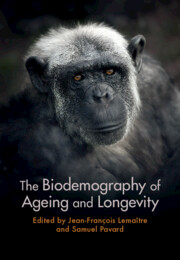Book contents
- The Biodemography of Ageing and Longevity
- The Biodemography of Ageing and Longevity
- Copyright page
- Dedication
- Contents
- Contributors
- Foreword
- Acknowledgements
- 1 The Eternal Youth of Ageing Research
- 2 Theories of Ageing across Ages
- 3 The Diversity of Longevity Metrics
- 4 The Meaning of ‘Exceptional Longevity’
- 5 The Inevitability of Senescence
- 6 The Untapped Potential of Zoo and Aquarium Data for the Comparative Biology of Ageing
- 7 Perspectives in Comparative Biology of Ageing
- 8 An Integrative Approach to Understanding Variation in the Form, Pattern and Pace of Ageing
- 9 Sex Differences in Lifespan, Ageing and Health in the Living World
- 10 Evolution of Human Reproduction, Ageing and Longevity
- 11 Lifespan and Mortality in Hunter-Gatherer and Other Subsistence Populations
- 12 Longevity in Modern Populations
- 13 Health Transition and Population Ageing
- 14 Limit of Human Longevity
- 15 Mortality Modelling at the Oldest Ages in Human Populations
- 16 Lessons from Exceptionally Long-Lived Individuals and Long-Living Families
- 17 Human Populations with Extreme Longevities
- 18 Socio-Economic Consequences of Increased Longevity in Contemporary Populations
- Index
- References
11 - Lifespan and Mortality in Hunter-Gatherer and Other Subsistence Populations
Published online by Cambridge University Press: 14 November 2024
- The Biodemography of Ageing and Longevity
- The Biodemography of Ageing and Longevity
- Copyright page
- Dedication
- Contents
- Contributors
- Foreword
- Acknowledgements
- 1 The Eternal Youth of Ageing Research
- 2 Theories of Ageing across Ages
- 3 The Diversity of Longevity Metrics
- 4 The Meaning of ‘Exceptional Longevity’
- 5 The Inevitability of Senescence
- 6 The Untapped Potential of Zoo and Aquarium Data for the Comparative Biology of Ageing
- 7 Perspectives in Comparative Biology of Ageing
- 8 An Integrative Approach to Understanding Variation in the Form, Pattern and Pace of Ageing
- 9 Sex Differences in Lifespan, Ageing and Health in the Living World
- 10 Evolution of Human Reproduction, Ageing and Longevity
- 11 Lifespan and Mortality in Hunter-Gatherer and Other Subsistence Populations
- 12 Longevity in Modern Populations
- 13 Health Transition and Population Ageing
- 14 Limit of Human Longevity
- 15 Mortality Modelling at the Oldest Ages in Human Populations
- 16 Lessons from Exceptionally Long-Lived Individuals and Long-Living Families
- 17 Human Populations with Extreme Longevities
- 18 Socio-Economic Consequences of Increased Longevity in Contemporary Populations
- Index
- References
Summary
The demography of contemporary hunter-gatherers, farmers and other subsistence populations provides an important lens for studying age patterns of survival and morbidity under non-industrial conditions and lifeways. Although high-quality evidence is sparse, a review suggests robust patterns of human longevity that contradict prior notions of ‘nasty, brutish and short’ lifespans suggested from the palaeodemographic literature. Life expectancy at birth averages about 30 years for hunter-gatherers, and 35 years across all human subsistence groups, a pattern similar to mid-eighteenth-century Europe. Despite short life expectancy, subsistence populations show a modal adult lifespan of about seven decades across a wide range of environments, diets and livelihoods. Over a third of adult life is spent post-reproductive. Infection, violence and accidents are primary causes of death. Post-contact acculturation has mostly improved survivorship, especially in early life, due to access to health care and modern amenities. Loss of land and livelihood, new infections and exploitation, however, have increased mortality and morbidity in some populations. Although the past two centuries have witnessed large gains in lifespan equality and survivorship, the potential for human longevity appears to be a species-typical universal.
- Type
- Chapter
- Information
- The Biodemography of Ageing and Longevity , pp. 217 - 238Publisher: Cambridge University PressPrint publication year: 2024

